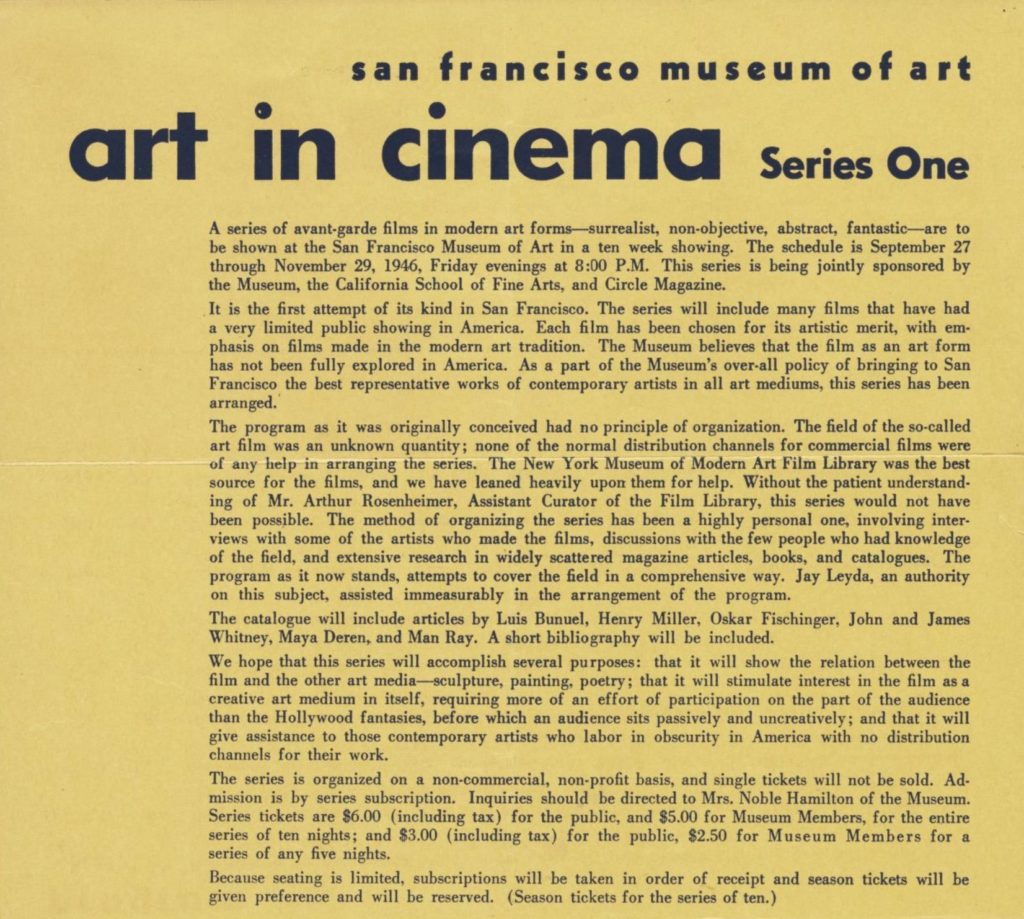Canyon Cinema Response to the Elimination of SFMOMA’s Film Program
Posted July 23rd, 2021 in Announcements, News / Events
SFMOMA’s recent decision to eliminate its Film Program (among other vital, inclusive, and community-focused programs) is a stunning disavowal of its own history. Moreso, it is a shocking divestment from SFMOMA’s stated commitment to “exhibiting film as an essential medium of modern and contemporary art” and to fostering a vibrant film culture in San Francisco. Following the renovation of its “state-of-the-art” Phyllis Wattis Theater in 2016, SFMOMA has demonstrated the ability, and financial willingness, to present film at the highest quality. Combining excellent film curation and world-class projection, SFMOMA has become a flagship of cinema exhibition in the Bay Area, which makes the decision to cut its Film Program especially puzzling.
It is disappointing and disheartening to learn that a museum that claims to be a center for “the most innovative and challenging art of its time,” now holds the medium of film and the projected moving image in such low regard. Since its creation in 1935, the museum has often been a leader in cultivating appreciation of film as an art form. As detailed by Brecht Andersch in Open Space, another indispensable SFMOMA program scheduled for deletion, the museum’s founding director, Grace L. McCann Morley began showing films there in 1937. SFMOMA’s influential Art in Cinema program, spearheaded by filmmaker Frank Stauffacher in 1946, was a bedrock for much of the Bay Area’s nascent avant-garde cinema and moving image culture, and a beacon for young, adventurous film artists who flocked to the city in the 1940s and 50s. In recent years, under the leadership of Gina Basso, SFMOMA has produced many wonderful cinema programs, often with little promotion, and provided a home to San Francisco Cinematheque’s CROSSROADS festival, which fully activated the museum’s beautifully refurbished cinema with an array of expanded, multi-projector performances. During the COVID-19 shutdown, thoughtfully curated online programs such as Assembly of Images: On Histories of Race and Representation and Always Moving: African American Portraiture in Film established a standard of excellence for streaming exhibitions.
San Francisco has always been at the heart of the international cinema scene, a clear alternative to the Hollywood model, and the city itself has supported this kind of work with vision, dedication, and risk. Whether conscious or not, SFMOMA’s decision to eliminate film from its offerings can only be seen as an attempt to diminish the medium’s importance within the field of contemporary artistic practice. When a museum self-described as “of Modern Art” scraps its Cinema program, it is betraying the entire historical arc of art as grand cultural expression and technologic investigation. It is forsaking an evolutionary pattern that not only summarizes tendencies in art but ignores the primacy of the moving image in culture-at-large. You might say discarding a film program in this moment qualifies a museum to be noted as Pre-Modern Art or Calcified Art if Art itself is a process and not a mere period.
How can the story of modern and contemporary art be told without cinema? Nearly every artist who has played a part in shaping and defining modern art have made films as part of their oeuvre, from Duchamp, Man Ray, and Leger, to Joseph Cornell, Robert Frank, Maya Deren, and Warhol, to Cindy Sherman, Shirin Neshat, Julian Schnabel, and Steve McQueen. How can the museum possibly claim itself as a Modern Art museum when this important part of their work is not included for exhibition. In addition, how can the story of San Francisco art history be told without the films of Bruce Conner, Sara Kathryn Arledge, Sidney Peterson, Gunvor Nelson, Chick Strand, Lawrence Jordan, George Kuchar, Barbara Hammer, Robert Nelson, Theresa Hak Kyung Cha, Jordan Belson, James Broughton, Dorothy Wiley, Al Wong, Bruce Baillie, Trinh T. Minh-ha, Will Hindle, Janis Crystal Lipzin, Mike Henderson, Kerry Laitala, Craig Baldwin, Greta Snider, Paul Clipson, and so many others?
Rationalizing the elimination of the Film Program as part of a “strategic refresh” aimed at attracting and engaging “a broader range of audiences” rings hollow to us.
SFMOMA needs more film, not less. Just like it needs more platforms that provide opportunity for underrepresented and emerging voices like Open Space; and more satellite projects that connect with and provide material support to local artists like Artists Gallery. It seems no small coincidence that the programs that have been marked for elimination are among the museum’s most adventurous and interactive programs, and most engaging of the Bay Area artistic community.
We, the staff and Board of Directors of Canyon Cinema Foundation, implore the managers of SFMOMA to reverse their decision to eliminate its Film Program, Open Space, and Artists Gallery. However, if SFMOMA elects to move forward with these announced changes, we demand the removal of the words “Modern Art” from the name of the museum. If this museum is going to strip film and the projected moving image—the quintessential modern art form—from its exhibition program, to continue using the term “modern” to define the museum is unethical, and false branding. Therefore we will no longer refer to it as a museum of modern art, and invite the community to help us rename the museum, to more accurately express what it is becoming. As an opening suggestion, we offer SFMOCO: The San Francisco Museum of the Commodified Object.
Sincerely,
Antonella Bonfanti
Brian L. Frye
Max Goldberg
Brett Kashmere
Jonathan Marlow
Rebecca Meyers
Seth Mitter
Michael Renov
Lynne Sachs
Steve Seid
Jeffrey Skoller




